-

人教版新目标初中英语九年级下册By the time I got outside, the bus had already left教案
Ⅰ. Teaching Aims and Demands1. Knowledge Objects(1) Key Vocabularyoversleep(2) Target LanguageWhat happened?I overslept. And by the time I got up, my brother had already gotten in the shower.2. Ability Objects(1) Teach the students to use the new words.(2) Train the students to narrate past events with the Past Perfect Tense.(3) Train the students' listening and speaking skills with the target language.3. Moral ObjectIt’s a good habit to go to bed early in the evening and get up early in the morning. So you’ll never be in a hurry in the morning.Ⅱ. Teaching Key Points1. Key Vocabularyoversleep2. Target LanguageNarrate past events with the Past Perfect TenseⅢ. Teaching Difficult Points1. Train the students to narrate past events with the Past Perfect Tense.2. Train the students to understand the target language in spoken conversation.Ⅳ. Teaching Methods1. Thinking of examples from the students' real lives.2. Making sentences by looking at the pictures.Ⅴ. Teaching AidA tape recorderⅥ. Teaching ProceduresStep I Revision1. Revise the language points in Unit 8.Ask some questions like this: What volunteer work would you like to do?Help the students to answer, I’d like to…/I love to…/I hope to2. Practice the dialogue in Activity 3c on page 62 again. Get students to role play the similar dialogues with the following.

人教版新目标初中英语九年级下册Rainy days make me sad教案
1. 教材分析本单元以how do things affect you?为话题, 从颜色、天气、音乐、广告、产品等方面谈论了外界事物如何影响人的心情。要求学生掌握表达某物或某事给人带来的感觉、看法或影响等。共设计了四个部分的内容:Section A 该部分有4个模块:第一模块围绕Which restaurant would you like to go to?这一话题展开思维(1a)、听力(1b)、口语(1c)训练;第二模块围绕How does music affect you? 进行听力(2a-2b)、口语训练(2c);第三模块继续围绕how do colors in the restaurant affect you这一话题展开训练,训练形式为阅读和问题体验(3a)和小组活动(3b);第四模块仍就How do things affect you这一话题以调查的形式展开讨论。Section B该部分有4个模块:第一模块围绕产品广告对人们的影响这一话题以“配对”(1a)与“列举”(1b)两种形式展开训练;第二模块继续围绕How do things affect you? 进行听力(2a-2b)、口语对话训练(2c);第三模块围绕“Advertising”这一话题展开阅读(3a-3b)和写作(3c)训练;第四模块围绕How posters affect you这一话题以口语训练形式展开小组活动。

人教版新目标初中英语九年级下册Could you please tell me where the restrooms are教案
Step Ⅰ RevisionCheck homework. Ask a few students to read the article in 3a.Then ask a few students to read their guides.Step Ⅱ Part 1Look at the words in the box. Ask a student to read them. Make sure the students understand the meaning of the words. You are to fill in the blanks with the words. In some cases, students may need to use another form of the word, for example adjusting for tense or subject/ verb agreement.Ask students to fill in the blanks on their own.Check the answers. Step ⅢPart 2Go through the instructions with the class.Look at the example with the students.Ask students what the answer would be.Ask a student to read the question and answer it.Excuse me, could you tell me where the bank is, please?The bank is across the street from the shopping malt.Get students to complete the work in pairs.Check the answers. Ask a few students to read their questions.Step Ⅳ Just for Fun!Ask all the students to read the conversation. Ask: What is funny about this cartoon? Help students to explain. A Martian is a person from the planet Mars.There is no such thing as Martian food on Earth, and the clerk looks silly because he is trying to think of where there is a Martian restaurant.Invite some pairs of students to present this conversation to the rest of the class.Step Ⅴ Summary and HomeworkIn this class, we’ve done much writing practice using the key vocabulary words and the target language presented in this unit. After class, please finish the questions in 2 in your exercise books. Then finish the exercises on pages 47~48 of the workbook as well.The Seventh Period Ⅰ Teaching Aims and Demands1. Knowledge Objects(1) Key Vocabularyimage, adventure, jealousy, hero, crime, journey, brave, no longer, show interest in, take it easy, become interested in, plain looks(2)Text:Grown-ups like cartoons, too.2. Ability Objects(1) Fast-reading to get a general idea of the text.(2) Careful-reading to get the detailed information in the text.

人教版新目标初中英语九年级下册I’ll help clean up the city parks教案
Talk about offering help (P60)I’ll help clean up the city parks.A: I’d like to work ...B: You could help ...Talk about ways to tell people about the Clean-Up Day (P61)We need to ...We can’t ...I’ll ...Talk about the work the volunteers do (P62)These three students all volunteer their time to help other people.Somebody loves to ... / helps ... / plans to ... / wants to ...A: What do you like doing?B: I like ... A: What kind of volunteer work do you think I could do?B: You could ...1. 重点词汇advertisement, fix, repair, pleasure, blind, deaf, shut, carry, specially, fetch2. 认读词汇hunger, homeless, cheer, clean-up, sign, establish, major, commitment, elementary, veterinarian, coach, similar, call-in, strategy, disabled, organization, unable, support, appreciate, donation, part of speech, pronoun, adverb, preposition, conjunction, donate, Jimmy, Sally3. 词组clean up, cheer up, give out, put off, set up, think up, take after, fix up, give away, put up, hand out, work out, at once

人教版新目标初中英语九年级下册We’re trying to save the manatees教案2篇
本单元主要围绕着有关濒临灭绝的动物这一话题,学习了应该怎样保护我们的环境,以及就某一问题展开辩论。目标提示语言目标能够运用所学知识,就某一问题展开辩论。认知目标1、复习一些语法:现在进行时、一般现在时、用used to 表示一般过去时、现在完成时、一般过去时的被动语态。2、学会表达同意和不同意。3、学会以下基本句型:We’re trying to save the manatees.Manatees eat about 100 pounds of food a day.There used to be a lot of manatees.In 1972,it was discovered that they were endangered.Some of the swamps have become polluted.情感目标了解一些濒临灭绝的动物的生活习性和濒临灭绝的原因,教育学生应该如何保护环境。教学提示充分利用多媒体等教学设备,创设与本课话题相关的情境,如各种不同种类的动物、动物园以及有关环境的画画等等。围绕着本单元的教学目标,设计一些贴近学生实际的教学任务,如让学生谈论自己最喜欢的动物,如何拯救濒危动物,如何保护环境等等。让学生根据所学知识,就动物园是否对动物有利以及其他的话题进行辩论。

人教版新目标初中英语九年级下册You’re supposed to shake hands教案
教学目标:1. 掌握本单元一些重点词汇的写法和用法。2. 学会自如谈论餐桌礼仪。Step 1 RevisionAsk some students to retell the customs at the table in France in the passage in 3a.Step 2 Self checkPart 1. Fill in each bland with the correct word given. Students do the exercises by themselves at first. Then check the answers. Ask the students to comprehend the sentences and help them point out uses of some words, like “arrive (at / in) sw., spend time / money on sth , spend time / money (in) doing sth.”Part 2. Read about Fan Ling’s experience in a western restaurant. Understand the passage. Point out some key points in the passage.1. be / get used to doing sth. 习惯做某事2. begin with = start with 以….开头3. crowd v. 挤满,塞满 the crowd 人群 crowded adj. 拥挤的Then students discuss about how she would solve her problem. Ask some to share their stories with others.Part 3. Complete the crossword by looking at the sentences on the left. Then check the answers.
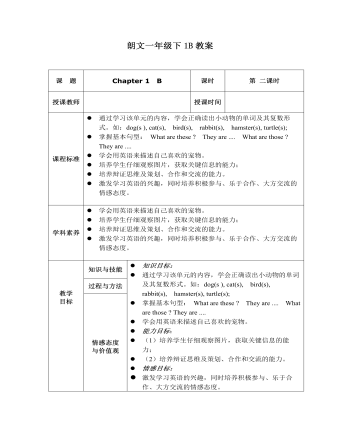
一年级朗文教材下册1B Chapter 1 B
l 通过学习该单元的内容,学会正确读出小动物的单词及其复数形式。如:dog(s ), cat(s), bird(s), rabbit(s), hamster(s), turtle(s);l 掌握基本句型: What are these ? They are .... What are those ? They are ....l 学会用英语来描述自己喜欢的宠物。l 培养学生仔细观察图片,获取关键信息的能力;l 培养辩证思维及策划、合作和交流的能力。l 激发学习英语的兴趣,同时培养积极参与、乐于合作、大方交流的情感态度。
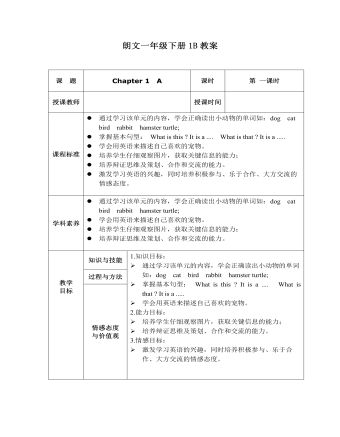
一年级朗文下册1B 教材 Chapter 1 A
l 通过学习该单元的内容,学会正确读出小动物的单词如:dog cat bird rabbit hamster turtle;l 掌握基本句型: What is this ? It is a .... What isthat ? It is a .....l 学会用英语来描述自己喜欢的宠物。l 培养学生仔细观察图片,获取关键信息的能力;l 培养辩证思维及策划、合作和交流的能力。l 激发学习英语的兴趣,同时培养积极参与、乐于合作、大方交流的情感态度。
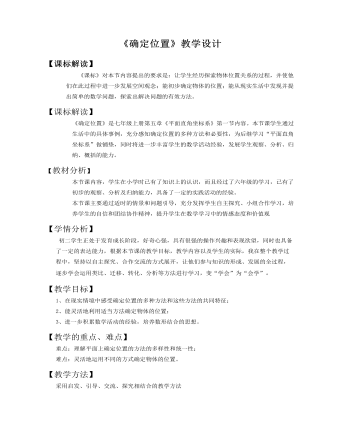
初中数学鲁教版七年级上册《第五章 位置与坐标 1 确定位置》教学设计教案
1、通过同位之间互说座位位置,检测知识目标2、3的达成效果。2、通过导学案上的探究一,检测知识目标2、3的达成效果。 3、通过探究二,检测知识目标1、3的达成效果。 4、通过课堂反馈,检测总体教学目标的达成效果。本节课遵循分层施教的原则,以适应不同学生的发展与提高,针对学生回答问题本着多鼓励、少批评的原则,具体从以下几方面进行评价:1、通过学生独立思考、参与小组交流和班级集体展示,教师课堂观察学生的表现,了解学生对知识的理解和掌握情况。教师进行适时的反应评价,同时促进学生的自评与互评。2、通过设计课堂互说座位、探究一、二及达标检测题,检测学习目标达成情况,同时有利于学生完成对自己的评价。3.通过课后作业,了解学生对本课时知识的掌握情况,同时又能检测学生分析解决问题的方法和思路,完成教学反馈评价。
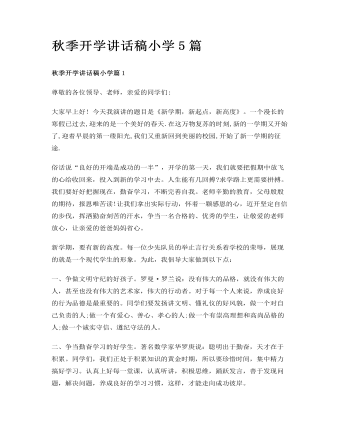
秋季开学讲话稿小学5篇
“民以食为天,食以安为先”,小小餐桌不仅传承了中华民族勤俭节约的优秀文化和传统美德,更承载着人民群众的身体健康和生命安全。为倡导“文明用餐,安全健康”的生活方式,引领“崇俭戒奢、文明守信”新风尚。为此,向全体师生发出倡议:一、倡导传统美德,弘扬文明新风。大力弘扬中华民族的传统美德,积极参与“文明餐桌”行动,“七不”劝导行动。“不乱扔垃圾、不随地吐痰、不乱贴乱画、不高空抛物、不大声喧哗、不扰乱公共秩序、不损害侵占公物”二、倡导勤俭惜福,反对铺张浪费。每位同学要崇尚绿色消费,理性消费,按需装饭,厉行节约,反对浪费,推行“光盘行动”,做到不剩饭、不剩菜。自觉遵守公共道德规范,爱护用餐环境,不在餐饮场所喧哗,注重餐饮礼仪,崇尚文明礼让。

大青树下的小学教案
《大青树下的小学》是统编教材小学语文三年级上册第一单元第一课。《大青树下的小学》是一篇精读课文,课文通过描写边疆的一所民族小学的孩子们幸福的学习生活,体现了祖国各民族之间的友爱和团结。课文层次清晰、段落分明。先写上学的路上和来学校的情景;再写上课时和下课后的情景,最后以自豪赞美的文字点题。学习本课我将引导学生通过对课文的整体把握和重点词句的理解,了解我国各民族儿童的友爱团结及他们幸福的学习生活,体会贯穿全文的自豪和赞美之情。
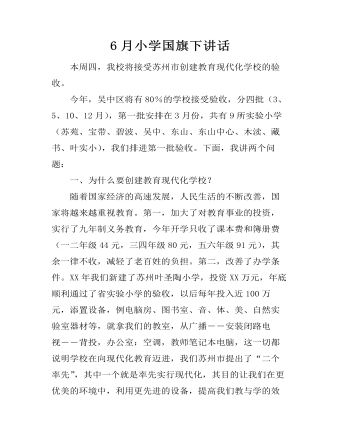
6月小学国旗下讲话
本周四,我校将接受苏州市创建教育现代化学校的验收。今年,吴中区将有80%的学校接受验收,分四批(3、5、10、12月),第一批安排在3月份,共有9所实验小学(苏苑、宝带、碧波、吴中、东山、东山中心、木渎、藏书、叶实小),我们排进第一批验收。下面,我讲两个问题:一、为什么要创建教育现代化学校?随着国家经济的高速发展,人民生活的不断改善,国家将越来越重视教育。第一,加大了对教育事业的投资,实行了九年制义务教育,今年开学只收了课本费和簿册费(一二年级44元,三四年级80元,五六年级91元),其余一律不收,减轻了老百姓的负担。第二,改善了办学条件。XX年我们新建了苏州叶圣陶小学,投资XX万元,年底顺利通过了省实验小学的验收,以后每年投入近100万元,添置设备,例电脑房、图书室、音、体、美、自然实验室器材等,就拿我们的教室,从广播――安装闭路电视――背投,办公室:空调,教师笔记本电脑,这一切都说明学校在向现代化教育迈进,我们苏州市提出了“二个率先”,其中一个就是率先实行现代化,其目的让我们在更优美的环境中,利用更先进的设备,提高我们教与学的效率,提高教学质量,使大家学得轻松,学得愉快。
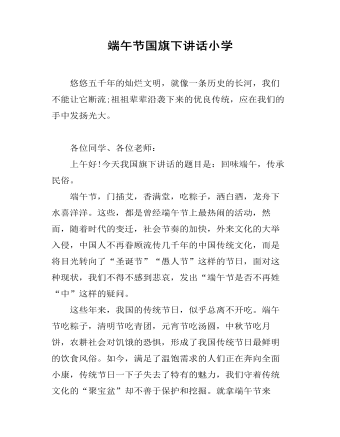
端午节国旗下讲话小学
悠悠五千年的灿烂文明,就像一条历史的长河,我们不能让它断流;祖祖辈辈沿袭下来的优良传统,应在我们的手中发扬光大。各位同学、各位老师:上午好!今天我国旗下讲话的题目是:回味端午,传承民俗。端午节,门插艾,香满堂,吃粽子,洒白酒,龙舟下水喜洋洋。这些,都是曾经端午节上最热闹的活动,然而,随着时代的变迁,社会节奏的加快,外来文化的大举入侵,中国人不再眷顾流传几千年的中国传统文化,而是将目光转向了“圣诞节”“愚人节”这样的节日,面对这种现状,我们不得不感到悲哀,发出“端午节是否不再姓“中”这样的疑问。这些年来,我国的传统节日,似乎总离不开吃。端午节吃粽子,清明节吃青团,元宵节吃汤圆,中秋节吃月饼,农耕社会对饥饿的恐惧,形成了我国传统节日最鲜明的饮食风俗。如今,满足了温饱需求的人们正在奔向全面小康,传统节日一下子失去了特有的魅力,我们守着传统文化的“聚宝盆”却不善于保护和挖掘。就拿端午节来说,它已融入各个临近国家的文化中,形成了独特的生命力——在新加坡,每年端午节举行的国际龙舟邀请赛闻名于世;在韩国,端午节被称为车轮节,是插秧结束后祈求丰年的日子。在很长一段时间里,中国人着眼于创新,却往往容易忽视对传统的坚持,文化的缺失必然导致精神断层甚至扭曲。有句话说的好:只有民族的才是世界的。在面临全球经济一体化的今天,该如何保护与继承我们的传统文化,显然已是一个不容回避的问题。而现时的洋节兴盛与传统节日衰弱间的反差,更凸显了这个问题的迫切性。
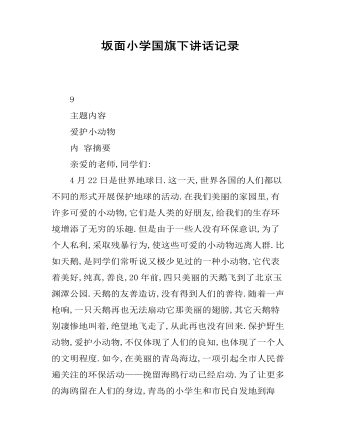
坂面小学国旗下讲话记录
9主题内容爱护小动物内 容摘要亲爱的老师,同学们:4月22日是世界地球日.这一天,世界各国的人们都以不同的形式开展保护地球的活动.在我们美丽的家园里,有许多可爱的小动物,它们是人类的好朋友,给我们的生存环境增添了无穷的乐趣.但是由于一些人没有环保意识,为了个人私利,采取残暴行为,使这些可爱的小动物远离人群.比如天鹅,是同学们常听说又极少见过的一种小动物,它代表着美好,纯真,善良,20年前,四只美丽的天鹅飞到了北京玉渊潭公园.天鹅的友善造访,没有得到人们的善待.随着一声枪响,一只天鹅再也无法扇动它那美丽的翅膀,其它天鹅特别凄惨地叫着,绝望地飞走了,从此再也没有回来.
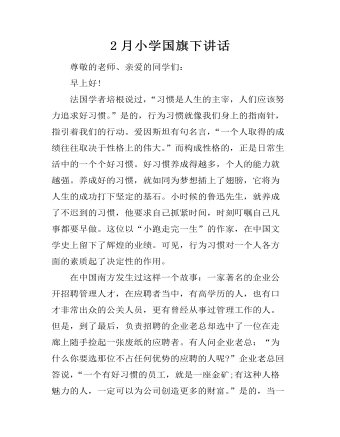
2月小学国旗下讲话
尊敬的老师、亲爱的同学们:早上好!法国学者培根说过,“习惯是人生的主宰,人们应该努力追求好习惯。”是的,行为习惯就像我们身上的指南针,指引着我们的行动。爱因斯坦有句名言,“一个人取得的成绩往往取决于性格上的伟大。”而构成性格的,正是日常生活中的一个个好习惯。好习惯养成得越多,个人的能力就越强。养成好的习惯,就如同为梦想插上了翅膀,它将为人生的成功打下坚定的基石。小时候的鲁迅先生,就养成了不迟到的习惯,他要求自己抓紧时间,时刻叮嘱自己凡事都要早做。这位以“小跑走完一生”的作家,在中国文学史上留下了辉煌的业绩。可见,行为习惯对一个人各方面的素质起了决定性的作用。在中国南方发生过这样一个故事:一家著名的企业公开招聘管理人才,在应聘者当中,有高学历的人,也有口才非常出众的公关人员,更有曾经从事过管理工作的人。但是,到了最后,负责招聘的企业老总却选中了一位在走廊上随手捡起一张废纸的应聘者。有人问企业老总:“为什么你要选那位不占任何优势的应聘的人呢?”企业老总回答说,“一个有好习惯的员工,就是一座金矿;有这种人格魅力的人,一定可以为公司创造更多的财富。”是的,当一个人养成了良好的习惯,他的人格魅力便会自然得到提升。

北师大初中七年级数学下册用尺规作角教案
解析:①以O为圆心,任意长为半径作弧交OA于D,交OB于C;②以O′为圆心,以同样长(OC长)为半径作弧,交O′B′于C′;③以C′为圆心,CD长为半径作弧交前弧于D′;④过D′作射线O′A′,∠A′O′B′为所求.解:如下图所示.【类型三】 利用尺规作角的和或差已知∠AOB,用尺规作图法作∠A′O′B′,使∠A′O′B′=2∠AOB.解析:先作一个角等于∠AOB,再以这个角的一边为边在其外部作一个角等于∠AOB,那么图中最大的角就是所求的角.解:作法:①作∠DO′B′=∠AOB;②在∠DO′B′的外部作∠A′O′D=∠AOB,∠A′O′B′就是所求的角(如下图).三、板书设计1.尺规作图2.用尺规作角本节课学习了有关尺规作图的相关知识,课堂教学内容以学生动手操作为主,在学生动手操作的过程中要鼓励学生大胆动手,培养学生的动手能力和书面语言表达能力
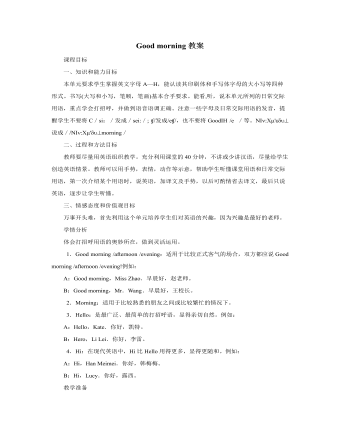
人教版新目标初中英语七年级上册Good morning教案
一、知识和能力目标本单元要求学生掌握英文字母A—H,能认读其印刷体和手写体字母的大小写等四种形式。书写(大写和小写,笔顺,笔画)基本合乎要求。能看,听,说本单元所列的日常交际用语,重点学会打招呼,并做到语音语调正确。注意一些字母及日常交际用语的发音,提醒学生不要将C/si:/发成/sei:/; ?/发成/e?/,也不要将Good?H /e /等。??????'????说成/???????'???morning/二、过程和方法目标教师要尽量用英语组织教学。充分利用课堂的40分钟,不讲或少讲汉语,尽量给学生创造英语情景。教师可以用手势,表情,动作等示意,帮助学生听懂课堂用语和日常交际用语,第一次介绍某个用语时,说英语,加译文及手势,以后可酌情省去译文,最后只说英语,逐步让学生听懂。
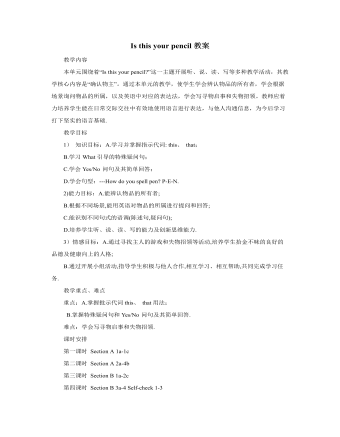
人教版新目标初中英语七年级上册Is this your pencil教案
T: Please look at the pictures and learn the new words.(用多媒体展示新单词效果较好。)1.at prep. 在(里面或附近);在(点刻);2.theart.表示特指的人、物、事或群体 3.lostadj.丢失的;遗失的4.Found adj. (find的过去式、过去分词)找回的5.lost and found 失物招领6.please adv.请7.school n. 学校8.a set of一套;一副(Teach students to read the words.)2. Practice the new words. (事先录制一段短的听力,让学生通过听的训练来强化所学的新单词,并为学习写寻物启示和失物招领作好准备。)T: Please listen to a short passage twice then fill the blanks using the words we learned.(Show students a short passage and play the recording for the students to listen.)There are many things in (1)_____________________in my (2)__________. Look, here’s (3)_________keys. Is this yours? (4)__________call Jim (5)___________753-2289.Typescript:There are many things in the Lost and Found in my school. Look, here’s a set of keys. Is this yours? Please call Jim at 753-2289.
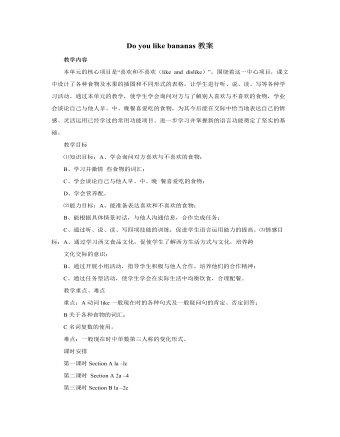
人教版新目标初中英语七年级上册Do you like bananas教案
教学目标 ⑴知识目标:A、学会询问对方喜欢与不喜欢的食物; B、学习并激情 些食物的词汇; C、学会谈论自己与他人早、中、晚 餐喜爱吃的食物; D、学会营养配。 ⑵能力目标:A、能准备表达喜欢和不喜欢的食物; B、能根据具体情景对话,与他人沟通信息,合作完成任务; C、通过听、说、读、写四项技能的训练,促进学生语言运用能力的提高。⑶情感目标:A、通过学习西文食品文化,促使学生了解西方生活方式与文化,培养跨 文化交际的意识; B、通过开展小组活动,指导学生积极与他人合作,培养他们的合作精神; C、通过任务型活动,使学生学会在实际生活中均衡饮食,合理配餐。 教学重点、难点 重点:A动词like一般现在时的各种句式及一般疑问句的肯定、否定回答; B关于各种食物的词汇; C名词复数的使用。 难点:一般现在时中单数第三人称的变化形式。
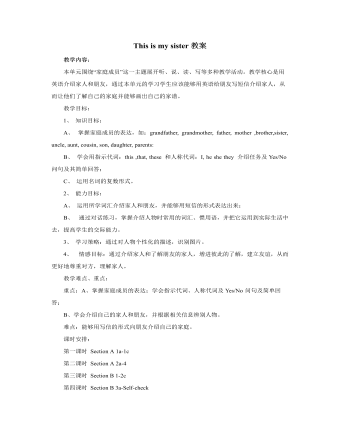
人教版新目标初中英语七年级上册This is my sister教案
(Play the recording twice again.) (Check the answer.) ③Pairwork. Draw your own picture and talk about it. T: We find out the picture of Lin Hai’s family. Can you draw a picture of your family? SS: … T: OK. When you finish drawing, tell your partner about your picture. You can use “This is …” and “ These are …” to talk about. Then report it to the class. (Students work.) (Check students’ work. Ask two or three students to report.) Step Three: Task. Talk about the family tree. T: Look at the family tree. I think it’s a big family. You can do it in groups of four or three. You can do it in pairs or only by yourself. Then report it to the class. (Students work. Teacher walks around in the classroom and helps the students.) T: Stop here. Let’s check it out. (Choose students to do it.) S1: Look at my family tree. This is my… This is my … They have two … This is my … This is my …This is my …This is my. My parents have two children. This is…This is my …My uncle and my aunt have a son. He is my … (Ask two more students to do it.) Homework. Write a passage about your family.

